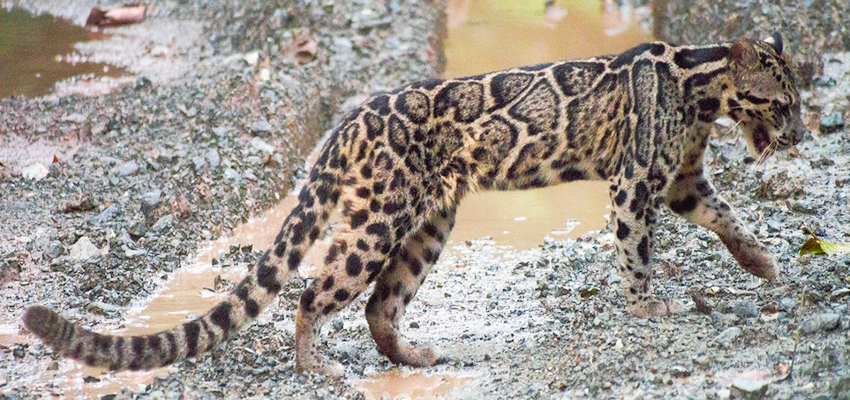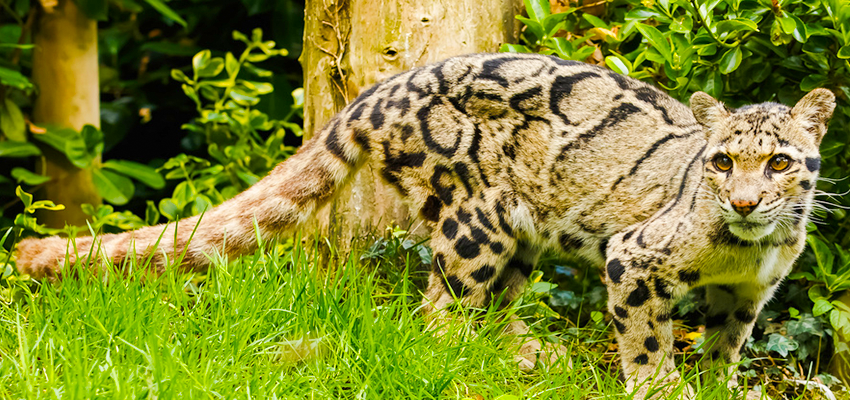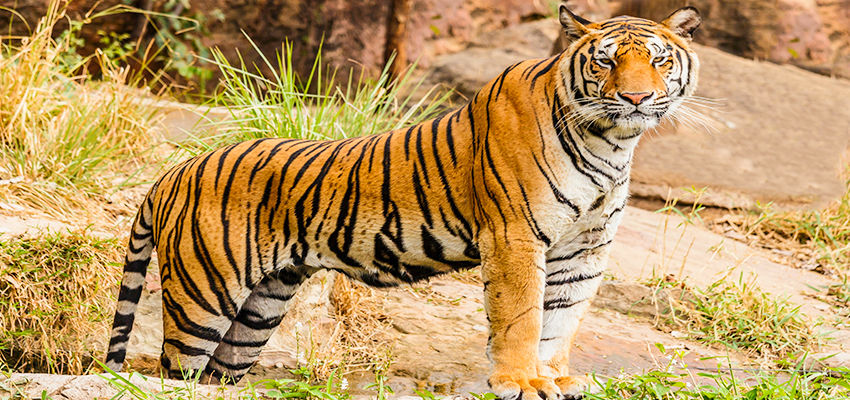When it comes to the largest cats in the world, there are a few contenders that come to mind. Some of the biggest are the lions, tigers, and jaguars. But which one reigns supreme? These different types of cats are usually bigger than their domestic counterparts, here is a list of the biggest cats in the world arranged in an increasing order of their respective weights.
1 SUNDA CLOUDED LEOPARDS

This Clouded Leopard is only found on the islands of Sumatra and Borneo and possesses especially short legs and a long tail that enable it to hunt monkeys efficiently on the trees. Sunda Clouded Leopard’s weight can reach up to 24 to 55 pounds (11-25 kg) and can grow up to 2-3.5 feet long without including tail and also has 2-3 feet tail length.
There was a time when researchers thought that the Sunda Clouded Leopard was related to the Mainland Clouded Leopard. The Sunda Clouded Leopard is a new species of leopard that isn’t recognized as a separate breeding population from the Mainland Clouded Leopard. Recent isolation for only a few million years has led to this kinship in which the Sunda and Mainland Clouded Leopards are more similar to each other than Jaguar and Leopard.
Although the Cat Specialist Group states that they are two different species. In regards to coat patterns, they’ve developed several differences.
2 MAINLAND CLOUDED LEOPARDS

The Smithsonian National Zoo explains that clouded Leopards (Neofelis nebulosa) are not considered to be true Leopards, but rather, actually a different species of cat. Clouded Leopards are small felines compared to leopards and other big cats such as lions and tigers. According to the San Diego Zoo, Clouded Leopards weigh can reach up to 25 kilograms (55 pounds) and can grow up to 1 meter (3.4 feet) long.
Clouded Leopards have great mobility and grasping abilities because of their big, dexterous paws and specialized ankle joints. Specialized canine teeth are also an interesting feature. They allow the clouded leopard to climb head first down trees; usually other animals need climbing harnesses for that sort of thing. The Clouded Leopard has some unique features, one being their long canines, their large, sharp canines make them unlike any other species of wild cat. Even though a Clouded Leopard’s average life span is generally 12 to 15 years, they may live up to 17 years in captive care.
Clouded Leopards, which are found in rare places like Nepal, Southeast Asia and China, have decreased in population due to human interference emptying the forest habitats of these cats and hunting them for their hides or use as a trophy. According to the International Union for Conservation of Nature (IUCN), forest clearing and poaching has fragmented and relapse their space. The Leopards eat different types of prey including slow loris, small deer, and more.
3 EURASIAN LYNX

Lynx are wildcat species, similar to house cats, but they have long black fur bunches on their ears and shorter tails. Lynxes are large felines found in North America, Europe and Asia with a number of different subspecies. Bobcats are the smallest of the four Lynx species and can be no more than double the size of a house cat while another Lynx may be a lot bigger.
According to the University of Michigan’s Animal Diversity Web (ADW), The Eurasian Lynx is the largest Lynx species and can grow up to 4.3 feet (1.3 meters) long and weigh can reach up to 79 pounds (36 kilograms). The Lynx, however, has a short tail of less than 9 inches in length and a long body, unlike the Snow Leopard which is quite different. Lynx generally eat different types of prey across its range that involves rodents, birds, as well as deer and other smaller mammals.
4 SNOW LEOPARDS

Snow Leopards, also known as snow cats (Panthera uncia), found in the mountains of central Asia and are among the most deceptive wild cats known. They also include countries such as Afghanistan and China. Snow Leopard Trust (S.L.T.) is a nonprofit institution that works to conserve these cats.
Like clouded Leopards, snow leopards also carry a name that has “Leopard” in it. Snow Leopards aren’t actually Leopards, but they belong to the same genus as lions and other big cats, like Leopards. They are in the same Panthera family as the leopards and are simply related. Snow leopards can reach up to 4.3 feet in length from head to tail but they can grow an additional 3.3 feet with their long tail so finally their weight can reach up to 54 kilograms (almost 120 pounds) per leopard.
Snow Leopards often target large grazing animals, such as wild sheep like Bharal, but the human footprint has reduced their habitat and prey. Like human predators, Snow Leopards have adapted to the changing landscape by preying on domesticated goats.
5 LEOPARDS

According to the San Diego Zoo, Leopards are agile and often spotted predators that roam through parts of Africa and Asia. These powerful carnivores generally can reach up to 6.2 feet long on average, keeping out the distance from their long tails, which can be additional 3.3 feet long. Leopard’s weights also can reach up to 165 pounds.
Leopard attacks are indeed a common occurrence. Leopard’s can get killed by other big cats, such as in Africa where lions kill and eat leopards to compete with them for dens and food, or in Asia where tigers hunt and kill lianas.
Despite the predators being more frequently noticed by scientists, leopards primarily target medium-sized prey such as gazelles and small deers and are mostly rarer than other, larger predators. ADW says, in order to avoid these hauntings at the same time as other predators, leopards hunt at dissimilar times and in dissimilar places than these other carnivores.
6 CHEETAHS

With the speed and size that no other land animal can match, Cheetahs are able to run at 112 km/h. These big cats, known for their black spots on white coats, can grow up to 7.3 feet in length, involving their white-dark tail. According to the Cheetah Conservation Fund (C.C.F.), Cheetahs usually weigh in the middle of 34-57 kg (75-125 pounds).
Cheetahs are found primarily in Northern, Eastern and Southern Africa. The Cheetah species is almost vanished in the Asian continent, but it still lives in a small population in Iran. Cheetahs typically consume small to medium-sized prey, especially gazelles.
According to research, Acinonyx pardinensis, an extinct species of giant Cheetahs that lived 1.8 million years ago, was found among the remains at a site in Georgia. The size of these elusive large cheetahs was estimated to weigh about 110 kg ( 220 pounds), and they were much larger than modern cheetahs today and the modern cheetah is just a third of its size.
7 PUMAS

A Puma (Puma concolor) is a native to the Americas and also is the most extensive large cat in this area. Pumas are known by many other names such as mountain lion, panther and cougar. According to Panthera, a cat conservation organization, they have a geographical range that extends from south Chile at the bottom of South America to southern Alaska and Canada in the western half of North America. One of the North American descendants of a South American species, puma range used to be very large, but were deterge out of eastern North America by human settlers. There are now just a few short populace that still remain in Florida.
Panthera recently wrote that many populations of Puma, the most iconic feline on Earth, have been declining in Central and South America due to risk factors such as habitat loss and poaching. However, it is difficult to count their numbers due to the lack of data and panthera states that this is largely unknown.
The National Wildlife Federation, a U.S. nonprofit conservation organization, has stated that Pumas can measure up to 8 feet long with their tails, and weigh up to 150 pounds, but some as large as 220 pounds have been recorded by them. According to the IUCN, North American Pumas often hunt deer.
8 JAGUARS

Jaguars, known by the scientific name: Panthera onca, are the largest big cat species in the Americas, and live in South, Central and North America. According to the International Union for Conservation of Nature (IUCN), They are primarily found in the Amazon rainforest. Jaguars are sometimes seen in the U.S. close to the Mexican border, meaning Cat sightings are fairly common in this area, but they are mostly done away with from their ancestral northern range which included parts of Arizona and New Mexico.
Jaguars grow up to be as long as 1.5 to 1.8 m when they’re except their tails and as long as 2.7 m when they have their long tails. Jaguars weigh an average of about 350 pounds. They eat a different type with a wide range of animals such as fish, monkeys and deer.
9 LIONS

“World’s second biggest cat species and have been crowned kings of the jungle is called the Lion. Their big heads, beautiful coats, and impressive size make them one of the few species in which a male will be larger than most female Lions.” Lions are often called “wild beasts” or “Kings of the jungle.” They are social cats that live in groups known as “Prides” and have lavish manes.
According to the National Zoo, male lions can grow up to 10 feet long, with some weighing as much as 500 pounds. Lions are disappearing in numbers but they can still be found almost everywhere in sub-Saharan Africa such as Tanzania, the Central African Republic and Botswana.
According to the International Union for Conservation of Nature, There is a separate population of Asiatic Lions existing in northwest India . Less individuals remain in this region and lions primarily eat medium to large-sized hunts like zebras and deer.
10 TIGERS

Big cats are usually classified as lions, but Tigers are a different species. Tigers are one of the biggest felines in the world. These large and gorgeous cats have conspicuous striped fur and can grow to lengths of up to 10 feet like other big cats such as lions, but are usually much heavier than Pumas. According to the (W.W.F.) World Wildlife Fund Tigers weight can reach up to 660 pounds, which is claimed as three times of weight than the heaviest Puma.
The Tiger is a big cat that can be found mostly in tropical Asia, including South and Southeast Asia. Tigers have also been spotted in Russia, Bhutan, and near the Russian peninsula of Kamchatka where they live at the top of the food chain. They hunt animals such as deer and wild pigs but are threatened by deforestation, According to the IUCN.
According to Panthera, Tigers were once even-more numerous, but they have dwindled significantly in the last hundred years because of human activity—encroachment and habitat fragmentation, they have quickly fallen and are now on the brink of extinction, with only 3,900 Tigers left living in the wild today.





